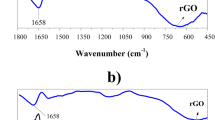Abstract
Graphene oxide–polyaniline composites were synthesized by an interfacial method using two green solvents, water and an ionic liquid (1-butyl-3-methylimidazolium tetrafluoroborate), as the two phases. The interfacial polymerization of aniline was carried out at room temperature in the presence of graphene oxide dispersed in the aqueous phase. The analysis revealed the surface of the graphene sheets to be coated with a smooth thin layer of polyaniline. The thermal stability of the composites was much better than that of bare graphene oxide. The composites were used to modify the glass carbon electrodes for the chemical detection of hydrogen peroxide in aqueous media. This method is a facile, efficient, and green route for the development of doped polyaniline materials suitable for chemical sensors.









Similar content being viewed by others
References
Novoselov KS, Geim AK, Morozov SV, Jiang D, Katsnelson MI, Grigorieva IV et al (2005) Two-dimensional gas of massless Dirac fermions in graphene. Nature 438:197–200
Zhang YB, Tan YW, Stormer HL, Kim P (2005) Experimental observation of the quantum Hall effect and Berry's phase in graphene. Nature 438:201–204
Dan YP, Lu Y, Kybert NJ, Luo JT, Johnson ATC (2009) Intrinsic response of graphene vapor sensors. Nano Lett 9:1472–1475
Robinson JT, Perkins FK, Snow ES, Wei ZQ, Sheehan PE (2008) Reduced graphene oxide molecular sensors. Nano Lett 8:3137–3140
Ohno Y, Maehashi K, Yamashiro Y, Matsumoto K (2009) Electrolyte-gated graphene field-effect transistors for detecting pH and protein adsorption. Nano Lett 9:3318–3322
Zhang K, Zhang WL, Choi HJ (2012) Facile fabrication of self-assembled PMMA/graphene oxide composite particles and their electroresponsive properties. Colloid Polym Sci. doi:10.1007/s00396-012-2814-8
Huang B, Li ZY, Liu ZR, Zhou G, Hao SG, Wu J, Gu BL, Duan WH (2008) Adsorption of gas molecules on graphene nanoribbons and its implication for nanoscale molecule sensor. J Phys Chem C 112:13442–13446
Zhang WL, Choi HJ (2012) Fabrication and electrorheology of graphene oxide/ionic N-substituted copolyaniline composite. Colloid Polym Sci. doi:10.1007/s00396-012-2872-y
Leenaerts O, Partoens B, Peeters FM (2008) Adsorption of H2O, NH3, CO, NO2, and NO on graphene: a first-principles study. Phys Rev B 77:125416–125422
Yang J, Burkinshaw SM, Zhou J, Monkman AP, Brown PJ (2003) Fabrication and characteristics of 2-acrylamino-2-methyl-1-propanesulfonic acid-doped polyaniline hollow fibers. Adv Mater 15:1081–1084
Alivisatos AP (1996) Semiconductor clusters, nanocrystals, and quantum dots. Science 271:933–937
Dhand C, Das M, Datta M, Malhotra BD (2011) Recent advances in polyaniline based biosensors. Biosens Bioelectron 26:2811–2821
Bhadra S, Khastgir D, Singha NK, Lee JH (2009) Progress in preparation, processing and applications of polyaniline. Prog Polym Sci 34:783–810
Sergeyeva TA, Lavrik NV, Piletsky SA, Rachkov AE, Elskaya AV (1996) Polyaniline label-based conductometric sensor for IgG detection. Sens Actuat B-Chem 34:283–288
Luo YC, Do JS (2004) Urea biosensor based on PANi(urease)-Nafion/Au composite electrode. Biosens Bioelectron 20:15–23
Wang Y, Li Z, Wang J, Li J, Lin Y (2011) Graphene and graphene oxide: biofunctionalization and applications in biotechnology. Trends Biotechnol 29:205–212
Huang X, Yin Z, Wu S, Qi X, He Q, Zhang Q et al (2011) Graphene-based materials: synthesis, characterization, properties, and applications. Small 7:1876–1902
Zhou X, Wu T, Hu B, Yang G, Han B (2010) Synthesis of graphene/polyaniline composite nanosheets mediated by polymerized ionic liquid. Chem Commun 46:3663–3665
Huang YF, Lin CW (2012) Polyaniline-intercalated graphene oxide sheet and its transition to a nanotube through a self-curling process. Polymer 53:1079–1085
Fan Y, Liu JH, Yang CP, Yu M, Liu P (2011) Graphene–polyaniline composite film modified electrode for voltammetric determination of 4-aminophenol. Sens Actuat B-Chem 157:669–674
Bao Y, Song J, Mao Y, Han D, Yang F, Niu L et al (2011) Graphene oxide-templated polyaniline microsheets toward simultaneous electrochemical determination of AA/DA/UA. Electroanalysis 23:878–884
Nguyen VH, Kim BK, Jo YL, Shim JJ (2012) Preparation and antibacterial activity of silver nanoparticles-decorated graphene composites. J Supercrit Fluid 72:28–35
Tang Q, Wu J, Sun H, Lin J, Fan S, Hu D (2008) Polyaniline/polyacrylamide conducting composite hydrogel with a porous structure. Carbohyd Polym 74:215–219
Pouget JP, Jozefowica ME, Epstein AJ, Tang X, MacDiarmid AG (1991) X-ray structure of polyaniline. Macromolecules 24:779–789
Wang H, Hao Q, Yang X, Lu L, Wang X (2010) Effect of graphene oxide on the properties of its composite with polyaniline. ACS Appl Mater Inter 2:821–828
Hu H, Wang X, Wang J, Wan L, Liu F, Zheng H et al (2010) Preparation and properties of graphene nanosheets–polystyrene nanocomposites via in situ emulsion polymerization. Chem Phys Lett 484:247–253
Fan X, Peng W, Li Y, Li X, Wang S, Zhang G et al (2008) Deoxygenation of exfoliated graphite oxide under alkaline conditions: a green route to graphene preparation. Adv Mater 20:4490–4493
Chitara B, Krupanidhi SB, Rao CNR (2011) Solution processed reduced graphene oxide ultraviolet detector. Appl Phys Lett 99:113114–113116
Stejskal J, Kratochvil P, Radhakrishnan N (1993) Polyaniline dispersions 2. UV–Vis absorption spectra. Synth Met 61:225–231
Laviron E (1979) General expression of the linear potential sweep voltammogram in the case of diffusionless electrochemical systems. J Electroanal Chem Interfac 101:19–28
Acknowledgments
This study was supported by the Basic Science Research Program through the National Research Foundation of Korea funded by the Ministry of Education, Science and Technology (2012009529).
Author information
Authors and Affiliations
Corresponding author
Rights and permissions
About this article
Cite this article
Nguyen, V.H., Tang, L. & Shim, JJ. Electrochemical property of graphene oxide/polyaniline composite prepared by in situ interfacial polymerization. Colloid Polym Sci 291, 2237–2243 (2013). https://doi.org/10.1007/s00396-013-2940-y
Received:
Revised:
Accepted:
Published:
Issue Date:
DOI: https://doi.org/10.1007/s00396-013-2940-y




